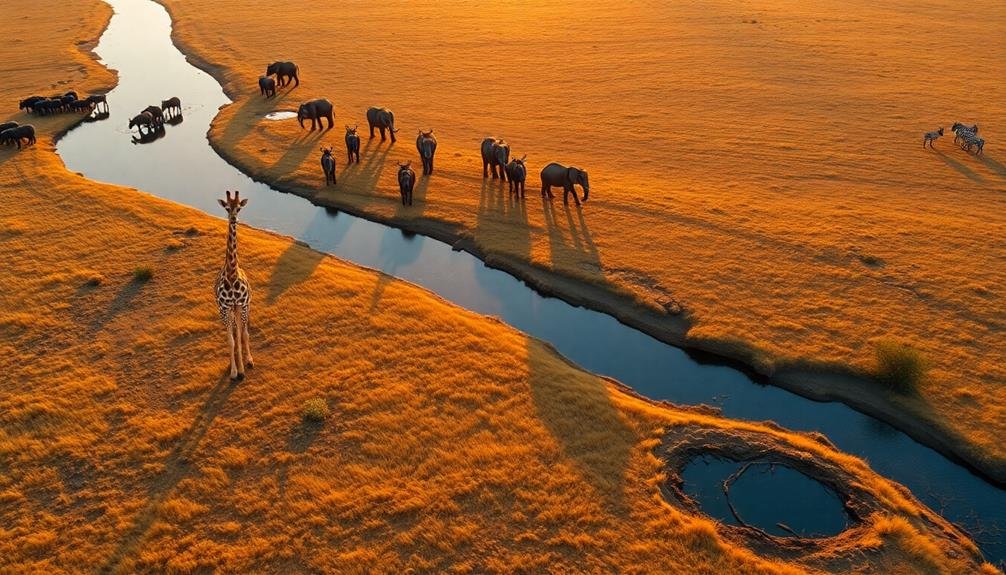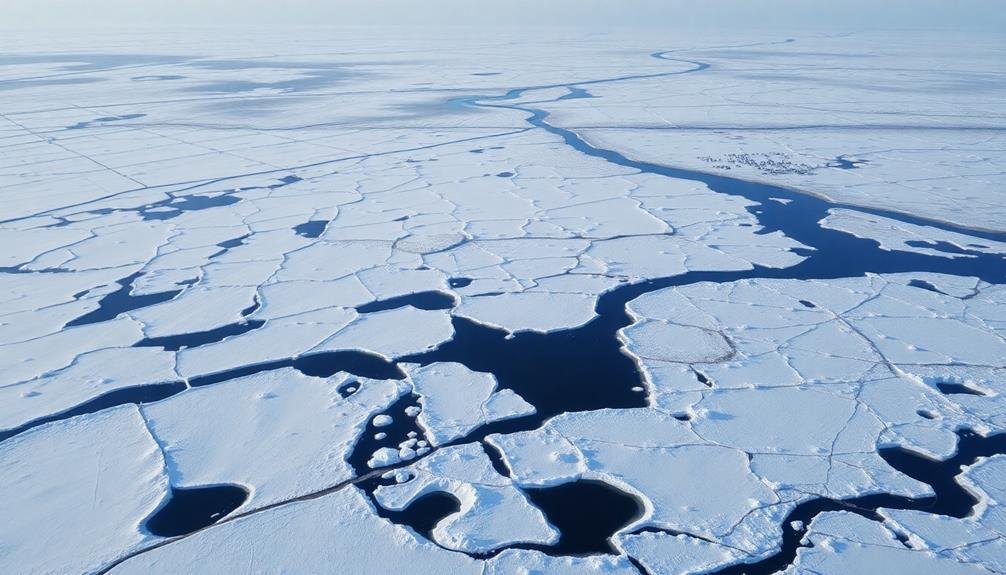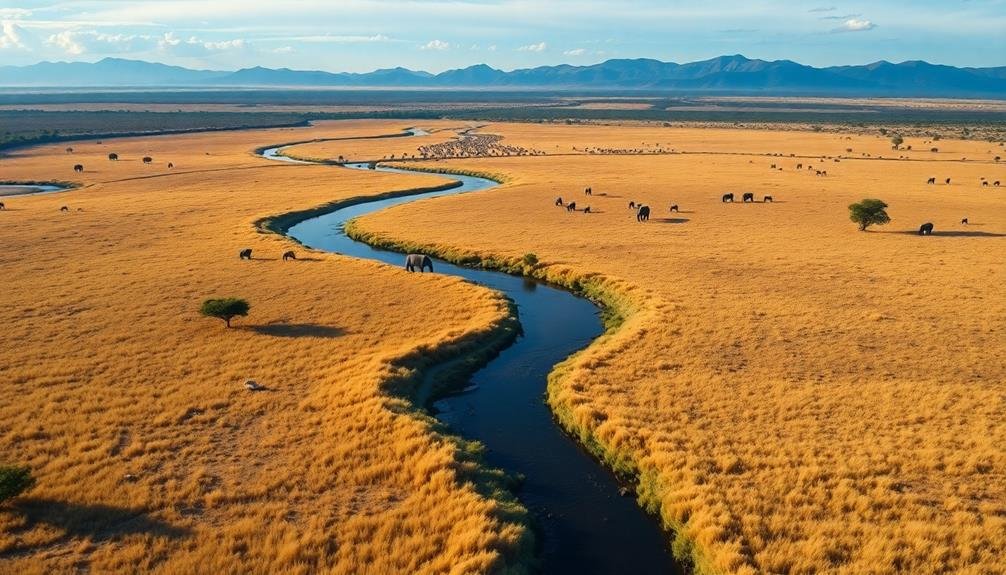You'll be awestruck by these three mesmerizing drone views of animal kingdoms. From high above, the African savanna discloses vast grasslands dotted with acacia trees, where elephant herds create dusty trails and zebra stripes stand out against the golden landscape. Underwater, coral reefs transform into vibrant metropolises, showcasing a kaleidoscope of colors and teeming marine life. In the Arctic tundra, intricate patterns emerge, with polygonal ground formations and shimmering thermokarst lakes painting a unique picture. These aerial perspectives offer a fresh look at wildlife habitats, revealing hidden behaviors and ecosystem connections you've never imagined before.
African Savanna From Above

As you soar above the African savanna in a drone, you'll witness a breathtaking tapestry of life unfold beneath you. The vast grasslands stretch to the horizon, dotted with acacia trees and punctuated by watering holes.
From this unique vantage point, you'll spot herds of elephants leaving trails of dust as they lumber across the plains. You'll marvel at the zebras' striking black and white stripes, visible even from high above. Giraffes appear as gentle giants, their long necks reaching skyward as they browse treetops.
Lion prides rest in the shade, barely discernible amidst the golden grass. The drone's perspective reveals hidden patterns in animal behavior. You'll observe wildebeest migrations, their dark masses flowing like rivers across the landscape.
Hippos become visible in muddy waters, their bulk concealed beneath the surface. Crocodiles bask on riverbanks, while flamingos create pink splotches around alkaline lakes.
This aerial view offers insights into the savanna's ecosystem that ground-level observations can't match. You'll see how different species interact, share resources, and navigate their environment in ways previously unseen by human eyes.
Coral Reefs: Underwater Metropolis

Beneath the ocean's surface lies a vibrant underwater metropolis: the coral reef. As you glide your drone over these bustling ecosystems, you'll witness a kaleidoscope of colors and an intricate network of life.
From above, you'll see the reef's complex structure, with its branching corals, massive brain corals, and swaying sea fans. The drone's camera captures the contrast between the shallow, turquoise waters and the deeper, azure depths where the reef drops off.
You'll spot schools of tropical fish darting through coral canyons and larger predators patrolling the edges. Sea turtles may glide gracefully below, while rays sweep across sandy patches between coral outcrops.
The aerial perspective reveals the reef's true scale and layout. You'll notice how reefs form barriers along coastlines or create intricate patterns of atolls and lagoons.
The drone's view also highlights the reef's vulnerability, showing areas affected by bleaching or storm damage.
This bird's-eye view of coral reefs offers a unique insight into these underwater cities, showcasing their beauty, complexity, and importance to marine life.
Arctic Tundra's Hidden Patterns

Icy vastness stretches as far as the eye can see. As your drone soars over the Arctic tundra, you'll discover hidden patterns that aren't visible from the ground. The landscape discloses intricate networks of polygonal ground formations, created by the freezing and thawing of permafrost.
You'll spot meandering rivers carving their way through the terrain, their paths dictated by the underlying permafrost. These waterways create a mesmerizing tapestry of blue veins against the tundra's muted palette. From above, you'll notice how wildlife trails crisscross the landscape, forming well-worn paths that animals use year after year.
The drone's eye view reveals the tundra's true complexity:
- Patchwork of vegetation: mosses, lichens, and low-growing shrubs create a colorful mosaic
- Thermokarst lakes: scattered across the landscape like shimmering blue jewels
- Migrating herds: from caribou to muskoxen, their movements visible as dark specks against the vast expanse
This aerial perspective offers a unique insight into the Arctic ecosystem's delicate balance, revealing patterns and interactions that shape this seemingly barren yet vibrant environment.
Frequently Asked Questions
What Type of Drone Is Best for Capturing Wildlife Footage?
For capturing wildlife footage, you'll want a quiet drone with long battery life and a high-quality camera. Consider models like the DJI Mavic 3 or Autel EVO II Pro. They're reliable, stealthy, and produce stunning 4K footage.
Are There Legal Restrictions on Using Drones to Film Animals?
You'll face legal restrictions when filming animals with drones. You can't harass wildlife or disturb protected species. You must follow local and national park regulations, respect private property, and adhere to airspace rules. Always check laws before flying.
How Do Animals React to the Presence of Drones?
You'll find animals react differently to drones. Some may be curious, others scared or indifferent. Loud drones often startle wildlife. Birds might attack, while larger mammals may flee. It's essential to maintain a respectful distance when filming.
Can Drones Be Used for Wildlife Conservation Efforts?
You can use drones for wildlife conservation efforts. They're effective for monitoring populations, tracking migrations, detecting poachers, and evaluating habitats. You'll find they're less invasive than traditional methods and can access remote areas easily.
What Are the Ethical Considerations When Filming Animals With Drones?
You must consider animal welfare when filming with drones. Don't disturb habitats or cause stress. Respect wildlife's privacy and natural behaviors. Follow local regulations and obtain necessary permits. Always prioritize the animals' wellbeing over getting footage.
In Summary
You've soared over vast savannas, dived into vibrant coral cities, and revealed the Arctic's secrets. These drone views have given you a fresh perspective on nature's grand designs. You've witnessed the interconnectedness of ecosystems and the hidden beauty that often goes unseen. As technology advances, you'll continue to discover new ways to explore and appreciate Earth's diverse animal kingdoms. Keep looking up, down, and all around – there's always more to uncover.

As educators and advocates for responsible drone use, we’re committed to sharing our knowledge and expertise with aspiring aerial photographers.




Leave a Reply